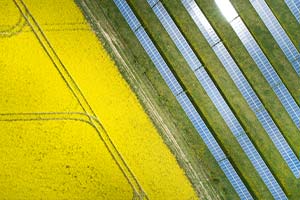Powering the National Food Strategy – The Rural Land Use Framework should consider green energy
Phil Thompson, CEO at Balance Power, talks to Farm Diversity about the National Food Strategy.
Last month, the National Food Strategy (NFS) was published – with findings set to make their way into a new government white paper in the coming months.
It’s encouraging to see that the NFS recognises farming communities as a source of pride and heritage, and that it highlights the importance of trade policy in ensuring UK food standards and protections for farmers.
 Wafer thin profit margins
Wafer thin profit margins
But many farmers are already struggling to make ends meet, as demonstrated aptly on Jeremy Clarkson’s recent farming series, Clarkson’s Farm, in which he made a grand sum of £144 at the end of a full year of toil; small profit margins are par for the course in today’s farming communities.
The latest release from DEFRA, which covers English farms in 2019-20, reveals that income for cereal farms decreased by 7%, the net profits for general cropping were down by 21% and lowland grazing livestock profits fell by 25% in just one year.
The NFS states that almost 40% of all farmers currently depend on a Basic Payment Scheme (BPS), allocated according to the amount of land being farmed, rather than the way it’s farmed, to remain solvent. However, these subsidies are being phased out, and the environment is likely to get tougher.
So how then, will farmers meet the bold ambitions of the strategy and still make a sustainable living?
Changing land use
There are big changes coming as the government transforms the payment system to one of “public money for public goods”. Under its new Environmental Land Management scheme (ELMs), “farmers will no longer receive payments for commercial activities such as producing crops, or simply for owning land, but for activities that contribute to the common, public good”. This includes things like nature restoration, managing woodland, flood prevention, soil improvement, animal welfare and carbon sequestration.
The situation is incredibly nuanced, but on a broad level, I’m for the ELMs as its introduction highlights the importance of making land work in different ways and, on a more practical level, there needs to be a replacement to plug the gap left by the removal of the BPS. However, neither the ELMs nor the NFS’s recommendations for a Rural Land Use Framework, includes the development of green energy projects, which is a huge flaw in the plans – and one that certainly isn’t going to progress us on the road to net zero.
Time for a balanced approach
Land diversification to accommodate green energy projects is, and will continue to be, integral to a sustainable future – both in environmental terms and for farming itself.
More farmers are looking at green energy projects as a viable option that provides an opportunity for them to ‘do their bit’ for climate change and secure long-term financial security, whilst allowing their family to continue working the land when they may not otherwise be able to afford to anymore.
A 2021 survey of farmers showed that 37% were already using some of their land for non-farming activities, which includes renewables. With rapid advancements in technology, it is possible to strike a balance between restoring and protecting nature, producing food through a transition to agroecology, and managing other competing demands on land.
That said, any change in land use should be market-driven and yield positive incentives rather than compulsion – and not come at the expense of a farmer’s profits.
A good crop yield can bring in £1,485 per hectare a year; solar projects can provide at least as much income, whether in place of farming or in parallel with more traditional crop production and grazing, and that's before you include the substantial increase that battery storage can bring if the site is suitable. The revenue that these projects produce is guaranteed and doesn’t require farmers to be propped up by the ELMs and poorly designed, ultimately unsustainable subsidies.
It can be a real head and heart decision to diversify land that could have been in the family for years, and one that takes courage and an appreciation of the bigger picture. But as we collectively look for new ways to power a carbon-free future, the decisions that landowners make over their land now, will be crucial. I would therefore encourage farmers to engage with energy companies to explore the potential for an energy project on their land, and urge the government to include green energy within the upcoming white paper and any future materialisation of the Rural Land Use Framework.
For more information, visit balancepower.co.uk.
- Log in to post comments

